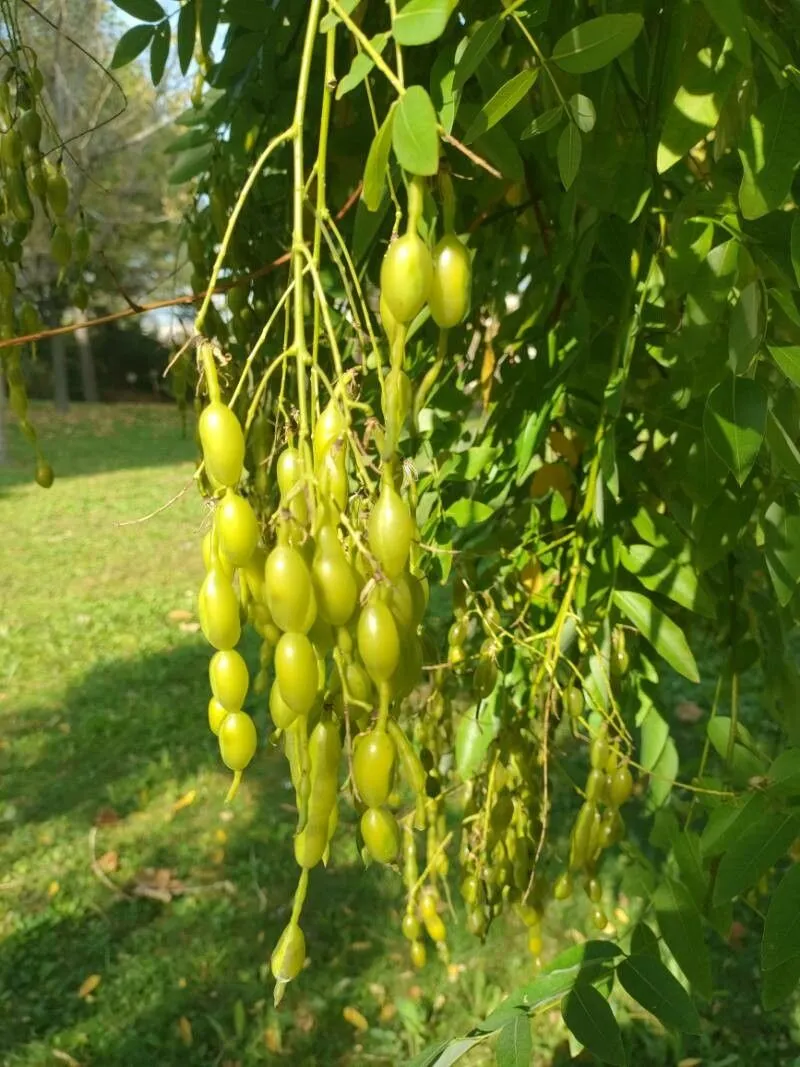
Author: (L.) Schott
Bibliography: Wiener Z. Kunst 3: 844 (1829)
Year: 1829
Status: accepted
Rank: species
Genus: Styphnolobium
Vegetable: False
Observations: C. & S. China
The Japanese pagoda-tree, scientifically known as Styphnolobium japonicum, is a remarkable species belonging to the Fabaceae family. This tree has garnered admiration not only for its striking appearance but also for its historical and horticultural significance.
The origin and natural habitat of the Japanese pagoda-tree trace back to central and southern China, where it thrives in diverse climatic conditions. Notably referenced in Wiener Z. Kunst in 1829 and classified by the botanist L. Schott, this tree has been well-documented in botanical literature due to its unique characteristics.
Recognizable by its elegant branching pattern and lush foliage, the Japanese pagoda-tree is a deciduous species that can grow to impressive heights. It typically produces dense clusters of creamy white flowers during the summer months, which later transform into distinctive, bead-like seed pods. The tree’s compound leaves, made up of numerous small leaflets, contribute to its delicate and airy appearance, making it a popular choice for ornamental planting.
Beyond its aesthetic appeal, the Japanese pagoda-tree holds considerable importance in various cultural contexts. In China, it has been traditionally planted near temples and pagodas, symbolizing endurance and resilience. Its robust nature and ability to adapt to urban environments also make it a preferred choice for city landscaping and public parks.
In addition to its ornamental use, the Japanese pagoda-tree has various ecological benefits. Its ability to fix nitrogen in the soil contributes to soil fertility, and its flowers are an excellent source of nectar for pollinators. As such, it plays a vital role in supporting local ecosystems.
Overall, the Japanese pagoda-tree is an essential and versatile species within the Fabaceae family. Its aesthetic charm, cultural significance, and ecological contributions make it a cherished tree in both natural and managed landscapes.
Eng: chinese scholartree, japanese pagoda tree, japanese pagoda-tree, pagoda-tree
Deu: perlenschnurbaum
Ita: sofora
Fra: sophora du japon
Spa: acacia bastarda, acacia del japón, sófora, sófora del japón, árbol de las pagodas
Hun: közönséges japánakác
Swe: pagodträd
Por: sófora-do-japão
Nld: japanse honingboom
En: Japanese pagoda-tree, Pagoda-tree, Chinese scholartree, Japanese pagoda tree, Pagoda tree, Scholar-tree, Scholar tree, Chinese Scholar Tree, Japanese Pagodatree
Af: Pagodeboom
Ar: صفيرا اليابان
Hy: Սոֆորա ճապոնական
Az: Yapon soforası
Eu: Japoniar sofora
Bg: Японска софора
Ca: Acàcia del Japó, Sòfora
Zh: Huai, 槐, 槐树
Cs: Jerlín japonský
Da: Pagodetræ-slægten
Nl: Honingboom, Japanse honingboom, Pagodeboom
Fr: Sophora du Japon, Arbre de miel, Sophore du Japon
Gl: Sófora
De: Japanischer Schnurbaum, Perlenschnurbaum, Japanischer Perlschnurbaum, Pagodenbaum
Hu: Közönséges pagodafa, Közönséges japánakác
It: Sofora, Sofora del Giappone, Robinia del Giappone, Sofora giapponese
Ja: Enju
Ko: Hoehwanamu, 회화나무
No: Pagodetre
Fa: تلخهبیان
Pl: Perełkowiec japoński
Pt: Sófora-do-japão
Ru: Софора японская
Sr: Sofora
Sk: Sofora japonská
Es: Acacia del Japón, Sophora japonica, Acacia bastarda, Sófora, Sófora del Japón, Árbol de las pagodas, Sofora
Sv: Pagodträd, Pagodträdssläktet
Ta: கோபுர மரம்
Tr: Japon soforası
Uk: Софора японська
Vi: Hòe
© copyright of the Board of Trustees of the Royal Botanic Gardens, Kew.
© copyright of the Board of Trustees of the Royal Botanic Gardens, Kew.
© copyright of the Board of Trustees of the Royal Botanic Gardens, Kew.
Taken Oct 2, 2022 by Kristof Fransen (cc-by-sa)
Taken Mar 14, 2020 by Anna G (cc-by-sa)
Taken Nov 26, 2019 by dgarciab (cc-by-sa)
Taken Aug 15, 2022 by William Coville (cc-by-sa)
Taken Sep 29, 2020 by Diego Alex (cc-by-sa)
Taken Sep 27, 2013 by EOL − Ignacio Vargas (cc-by-nc)
Taken Sep 9, 2009 by EOL − Jan Ševčík (public)
Taken Oct 12, 2022 by Ilenia Murgia (cc-by-sa)
Taken Mar 14, 2020 by Anna G (cc-by-sa)
Taken Oct 19, 2018 by Mehmet Basbag (cc-by-sa)
Taken Jul 9, 2020 by Salomon NOHRA (cc-by-sa)
Taken Jul 10, 2022 by Massimo Nattino (cc-by-sa)
Taken Jul 18, 2022 by Amélie Dusset (cc-by-sa)
Taken Mar 14, 2020 by Anna G (cc-by-sa)
Taken Aug 15, 2022 by William Coville (cc-by-sa)
Taken Feb 26, 2022 by Ha Anna (cc-by-sa)
Taken Sep 11, 2021 by Fabrice Rubio (cc-by-sa)
Taken Sep 14, 2022 by Jhonatan Diaz Coronado (cc-by-sa)
Taken Mar 14, 2020 by Anna G (cc-by-sa)
Taken Aug 15, 2022 by William Coville (cc-by-sa)
Taken Sep 27, 2013 by EOL − Ignacio Vargas (cc-by-nc)
Taken Aug 30, 2020 by Del Prete Fabio (cc-by-sa)
Taken Oct 4, 2020 by Wolf Phillip (cc-by-sa)
Taken Oct 10, 2018 by Mehmet Basbag (cc-by-sa)
Taken Oct 19, 2018 by Mehmet Basbag (cc-by-sa)
Taken Aug 27, 2021 by R. de Castro Ricardo (cc-by-sa)
Taken Oct 10, 2019 by Fedan Hacizade (cc-by-sa)
Taken Apr 8, 2022 by Corredoira Marta (cc-by-sa)
Taken Feb 26, 2022 by Ha Anna (cc-by-sa)
Growth habit: Tree
Ph maximum: 7.0
Ph minimum: 6.5
Light: 8
Atmospheric humidity: 4
Soil nutriments: 6
Family: Myrtaceae Author: (F.Muell.) K.D.Hill & L.A.S.Johnson Bibliography: Telopea 6: 402 (1995) Year: 1995 Status:…
Family: Rubiaceae Author: Pierre ex A.Froehner Bibliography: Notizbl. Bot. Gart. Berlin-Dahlem 1: 237 (1897) Year:…
Family: Sapindaceae Author: Koidz. Bibliography: J. Coll. Sci. Imp. Univ. Tokyo 32(1): 38 (1911) Year:…
Family: Asteraceae Author: A.Gray Bibliography: Pacif. Railr. Rep.: 107 (1857) Year: 1857 Status: accepted Rank:…
Family: Fabaceae Author: Medik. Bibliography: Vorles. Churpfälz. Phys.-Ökon. Ges. 2: 398 (1787) Year: 1787 Status:…
Family: Aspleniaceae Author: (Cav.) Alston Bibliography: Bull. Misc. Inform. Kew 1932: 309 (1932) Year: 1932…